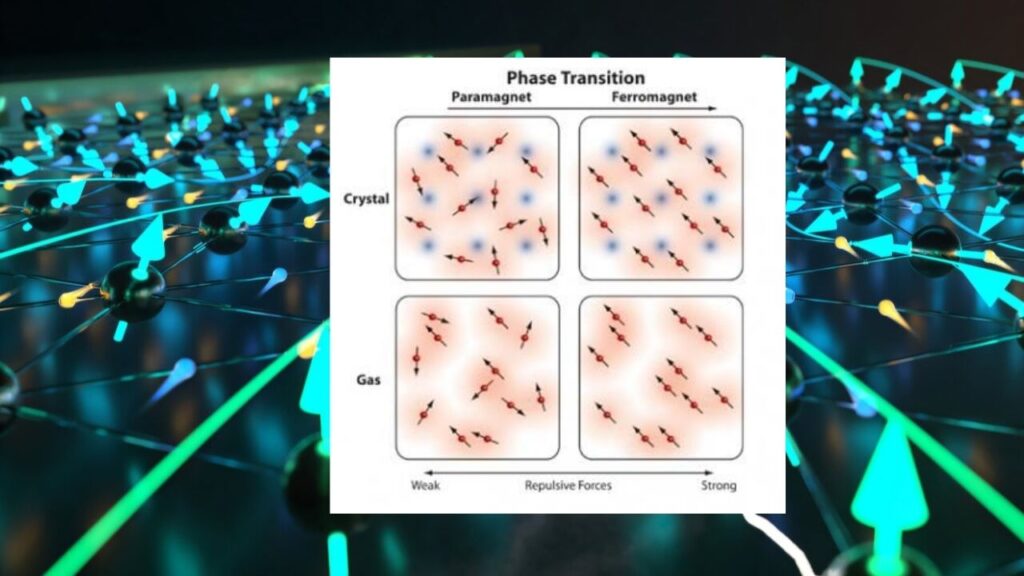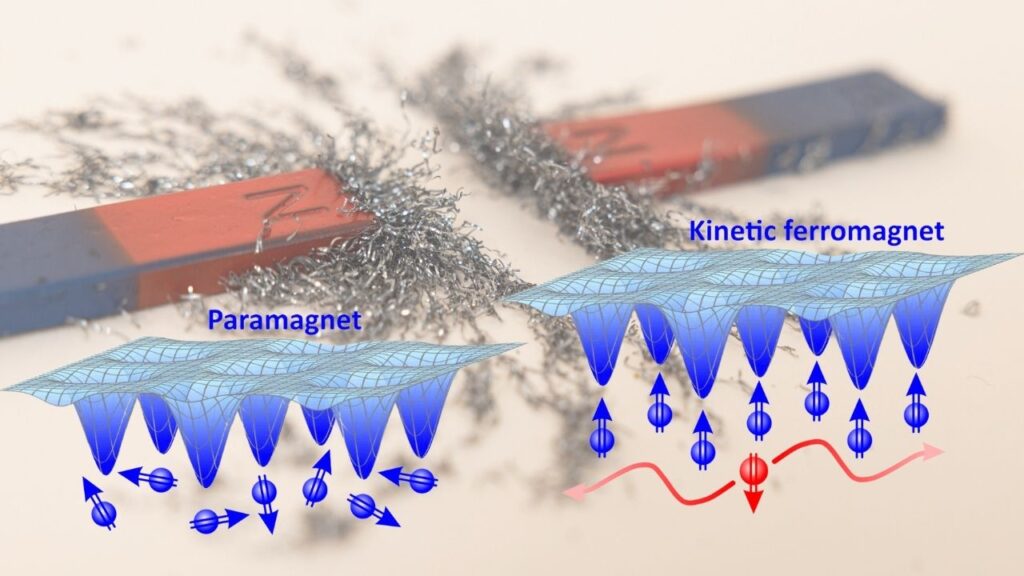Secret Behind Magnetism at the Atomic Level: Magnetism is a fundamental force that shapes much of our modern world—from the compass that guides explorers to the memory chips in our smartphones. For decades, scientists have studied how magnetism works at the atomic level, but recently, physicists have made groundbreaking discoveries that unlock deeper secrets about magnetism’s nature.

These insights reveal entirely new types of magnetism and mechanisms behind magnetic behavior, opening exciting opportunities for future technology. This article will explore these discoveries in detail, explaining the science in clear terms and showing why they matter.
What Is Magnetism? A Quick Refresher
At its core, magnetism arises because of the motion and spin of electrons within atoms. Electrons behave like tiny magnets due to their spin—a quantum property. When many electron spins align in a material, the combined effect creates a magnetic field that we can observe at a larger scale.
Historically, physicists recognized two main kinds of magnetism:
- Ferromagnetism: Seen in materials like iron, cobalt, and nickel, where electron spins align parallel to each other, resulting in a strong, permanent magnetic field.
- Antiferromagnetism: Where adjacent electron spins align antiparallel (opposite directions), canceling each other’s magnetic effects and resulting in no overall magnetism.

These two forms explained much about how magnets work but left some magnetic phenomena unexplained — until recent discoveries introduced new categories.
Secret Behind Magnetism at the Atomic Level
| Discovery | Institution | Material/System Studied | Key Insight | Applications & Potential |
|---|---|---|---|---|
| Altermagnetism | University of Nottingham | Manganese Telluride (MnTe) | A new third form of magnetism with unique spin arrangements and no net magnetic field | Ultra-fast, energy-efficient spintronic devices |
| Kinetic Magnetism | Princeton University | Ultracold atoms in optical lattices | Magnetism arising from motion of dopants (electron impurities), not static spins | Tunable magnetic materials for next-gen electronics |
| Orbital Magnetism in Graphene | MIT | Trilayer twisted graphene | Electron orbital effects produce magnetism at higher temperatures than expected | Quantum computing platforms, twistronics |
| Light-Induced Magnetism | MIT | Antiferromagnetic materials | Terahertz laser pulses induce long-lasting magnetic states by exciting atomic vibrations | Ultrafast magnetic switching for memory and logic devices |
The unlocking of magnetism’s secrets at the atomic level is a landmark achievement in physics, revealing novel magnetic phases and control methods. These insights are not just academic—they have profound implications for how we design electronics, store data, and develop quantum technologies. As research continues, the coming years promise transformative advances driven by these magnetic breakthroughs, making devices faster, smaller, and greener.
Altermagnetism: The Third Form of Magnetism
What Is Altermagnetism?
In 2025, physicists at the University of Nottingham confirmed the existence of altermagnetism—a magnetic phase that sits apart from ferromagnetism and antiferromagnetism. Unlike the familiar magnetic behaviors where spins either align or cancel, altermagnets have electron spins arranged in a complex pattern that produces no net magnetization but still influences electronic behavior significantly.
How Was It Discovered?
Using state-of-the-art X-ray microscopy at Sweden’s MAX IV synchrotron, researchers directly imaged magnetic vortices in thin crystals of manganese telluride (MnTe). This confirmed altermagnetism’s predicted spin textures and their unique effects on electron transport.
Why Is It Important?
Altermagnets combine the robustness of antiferromagnets with the spin-dependent transport properties of ferromagnets. This could enable spintronic devices that operate faster and consume far less energy than current silicon-based electronics. Researchers predict that data processing speeds could increase up to 1000 times, with reduced heat generation.
Spintronics uses the electron’s spin rather than just its charge, potentially revolutionizing memory and logic circuits. Altermagnets could be the key to developing next-generation ultrafast computers.
Kinetic Magnetism: Magnetism from Motion

What Is Kinetic Magnetism?
Traditional magnetism arises from electrons’ spin alignments. Kinetic magnetism, however, is caused by the movement of electrons or atomic impurities (called dopants) within a material, rather than static spin orientation.
The Princeton University Experiment
Physicists at Princeton simulated electrons with ultracold atoms arranged in a laser-created optical lattice. They observed how moving dopants induced collective magnetic behavior even in conditions where no static spin alignment existed.
Implications
Kinetic magnetism challenges classical views by showing that magnetism can emerge dynamically from motion. This understanding could allow scientists to engineer materials with controllable magnetic properties for custom applications.
Practical uses include adaptive electronic components whose magnetic behavior can be tuned on demand, potentially leading to smarter sensors, faster memory, or quantum information devices.
Orbital Magnetism in Trilayer Graphene
Why Graphene?

Graphene—a single layer of carbon atoms arranged in a hexagonal lattice—is famed for its extraordinary strength and electrical properties. When multiple graphene layers are stacked with a small twist angle, known as moiré patterns, new electronic behaviors emerge.
MIT’s Discovery
MIT scientists found that a helically twisted trilayer graphene structure exhibited orbital magnetism, where the orbit of electrons contributes significantly to magnetism, not just their spin.
Remarkably, this magnetism persisted up to temperatures as high as 10 K (-263°C), unusually warm for carbon-based magnets.
What Does This Mean?
The ability to induce magnetism in graphene through twisting adds a new dimension to twistronics—a field exploring how rotating layers affects electronic behavior. This paves the way for quantum computing components and ultra-sensitive magnetic sensors made from lightweight, flexible materials.
Light-Induced Magnetism: Controlling Magnetism with Light Pulses
The Innovation
MIT researchers demonstrated that terahertz-frequency laser pulses can induce magnetic order in antiferromagnetic materials by exciting atomic vibrations. These vibrations shift the balance of atomic spins, creating a new magnetic phase that lasts milliseconds after the light source is turned off.
Why Is This Revolutionary?
Traditional magnetic switching uses electric currents, which generate heat and limit speed. Light-induced magnetism could allow:
- Ultrafast magnetic switching at speeds much faster than electric methods.
- Energy-efficient control of magnetic states, reducing heat and power consumption.
- Applications in next-gen memory chips and logic devices, potentially transforming data centers and computing.
Practical Implications for Industry and Research
For Electronics and Data Storage
The discovery of new magnetic states enables the design of smaller, faster, and more energy-efficient memory devices. Spintronic technologies based on altermagnetism and light-induced magnetism could replace traditional silicon memory, reducing heat and power use.
For Quantum Computing
Graphene-based orbital magnetism and tunable kinetic magnetism offer new platforms for developing quantum bits (qubits) that are stable and controllable, a key challenge in quantum computing.
For Material Science
Understanding these new magnetisms guides the synthesis of custom magnetic materials tailored for specific applications, from sensors to medical devices.
How You Can Learn More
If you’re interested in exploring magnetism further or considering a career in physics, here are some practical tips:
- Study the Basics: Start with high school physics focusing on electromagnetism and quantum mechanics.
- Use Online Resources: Websites like Physics.org, Khan Academy, and MIT OpenCourseWare provide free courses and videos.
- Follow Research Updates: Subscribe to newsletters from institutions like Princeton Physics, MIT News, and University of Nottingham Research.
- Attend Workshops or University Programs: Many universities offer summer research programs or workshops for students interested in physics.
Scientists Extend Quantum State Lifetimes Using Laser Pulses — A Major Leap for Quantum Tech
NASA’s SPHEREx Telescope Launches to Explore Universe’s Origins
Cleveland Clinic, IBM, and Hartree Centre Collaborate on Quantum Healthcare Research
FAQs About Secret Behind Magnetism at the Atomic Level
Q1: What is the main difference between altermagnetism and ferromagnetism?
Altermagnetism involves complex spin arrangements producing no net magnetic field, whereas ferromagnetism features all spins aligned in the same direction creating a strong magnetic field.
Q2: Can these new magnetic forms be observed in everyday materials?
Currently, many discoveries involve specially prepared materials like manganese telluride or engineered graphene. However, researchers are working on making such materials more accessible for practical uses.
Q3: How soon will these discoveries impact consumer technology?
While promising, translating lab discoveries into commercial products takes years of development, testing, and scaling. We can expect early spintronic devices and light-controlled memory technologies within the next decade.
Q4: Are there environmental benefits?
Yes. New magnetic materials and light-based switching methods can drastically reduce the energy consumption and heat generation in electronics, lowering the environmental footprint of data centers and devices.






